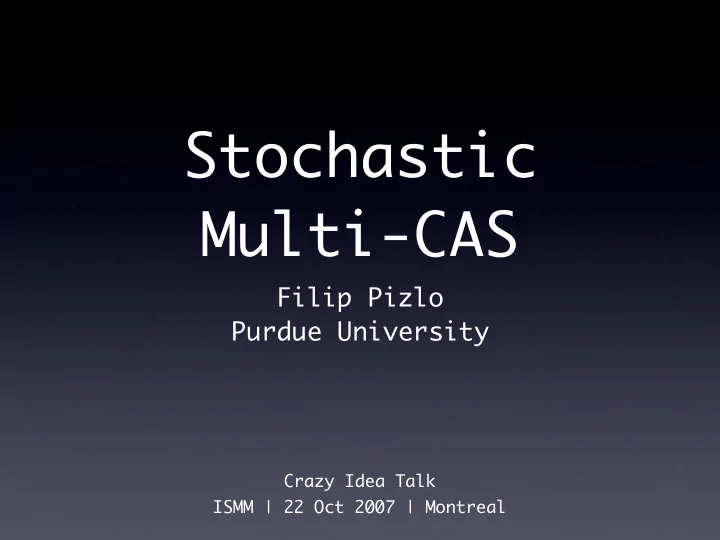

Stochastic Multi-CAS Filip Pizlo Purdue University Crazy Idea Talk ISMM | 22 Oct 2007 | Montreal
Compare and Swap If Target = Expected Value Then Target := New Value End Return Old Value
Compare and Swap • Compare and Swap (CAS) is essential for implementing interesting lock-free algorithms. • But existing CAS implementations are quite constrained...
The Problem • Hardware gives at best a 128- bit CAS. The bits must be contiguous in memory. • Lock-free software CAS implementations can relax this constraint - but they do so by stealing bits.
Why should you care? • Lots of algorithms can be easily made lock-free if we had practical multi-CAS. • Example: concurrent GC. • But bit stealing is intrusive.
• Stealing a bit is intrusive because: • vanilla C/C#/Java primitive types • we require that the client software be designed with an a priori knowledge about bit stealing.
Harris approach
Harris approach Hardware CAS-able word
Harris approach Hardware CAS-able word Steal one bit
Harris approach Hardware CAS-able word Either payload Steal one bit -or- CASN control data
Can we get 1 bit without stealing it?
Is there some way to cheat?
Yes!
Use a random number!
Stochastic approach
Stochastic approach Hardware CAS-able word
Stochastic approach Hardware CAS-able word All bits available
Stochastic approach Hardware CAS-able word !@#$%^&*&*$&^!^&$&%$^ When it comes to run multi-CAS, store random marker.
Stochastic approach Hardware CAS-able word !@#$%^&*&*$&^!^&$&%$^ When marker present, use remaining bits for multi-CAS control data.
Why is it good? • Can multi-CAS any field (including primitive fields) • The types don’t need to change • Lock-free, performance need not be atrocious.
What is the challenge? • Convincing people to use a stochastic algorithm.
Conclusion • An implementation already exists: http://homepage.mac.com/pizlo/smcas
Conclusion • An implementation already exists: http://homepage.mac.com/pizlo/smcas CAS throughput: 92ns/64bit!
Conclusion • An implementation already exists: http://homepage.mac.com/pizlo/smcas CAS throughput: 92ns/64bit! (Upper bounds. It’s faster per-field for larger Multi-CAS operations.)
Conclusion • An implementation already exists: http://homepage.mac.com/pizlo/smcas CAS throughput: 92ns/64bit! (Upper bounds. It’s faster per-field for larger Multi-CAS operations.) Read barrier throughput: ~2ns/64bit!
Recommend
More recommend